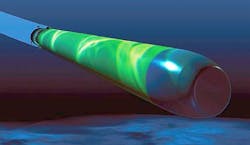Officials of the Naval Sea Systems Command in Washington are asking Sippican to provide 108 sonar upgrade kits for the Mark 48 Mod 7 torpedo, which is standard armament for the Navy's fleet of Los Angeles-, Virginia-, and Seawolf-class fast attack submarines, as well as Ohio-class ballistic- and cruise-missile submarines.
Sippican will provide Common Broadband Advanced Sonar System (CBASS) Functional Item Replacement (FIR) Kits, related engineering services to support CBASS FIR kits, CBASS FIR kit spares, and CBASS FIR kit warranty, Navy officials say.
The Lockheed Martin Corp. Mission Systems and Training segment in Washington is building the Mark 48 Mod 7 CBASS heavyweight torpedo with advanced common broadband advanced sonar system for expanded operational capabilities for shallow waters along coastlines and inside harbors, as well as in the deep-water open ocean.
The CBASS broadband sonar enhancement makes the torpedo more effective against emerging submarine classes in the harshest of acoustic environments, Lockheed Martin officials say.
The Mark 48 Mod 7 CBASS torpedo uses modern commercial-off-the-shelf (COTS) technologies in an open-architecture computing environment, and can be upgraded with regular hardware and software upgrades, Lockheed Martin officials say.
The Mark 48 Mod 7 CBASS kit’s evolutionary design and modular nature makes the upgrade of older version Mark 48 torpedoes to the Mod 7 CBASS capability a relatively straightforward effort without requiring significant torpedo redesign and certification, Lockheed Martin officials say.
Related: Boeing to make flying torpedoes able to attack enemy submarines from 30,000 feet
The goal of this contract modification is for Sippican to supply the Navy with upgrade kits consisting of a guidance and control box, broadband analog sonar receiver, preamplifier, cable assemblies, and guidance and control assembly materials, Navy officials say.
The CBASS torpedo also has the ability of multiband operation with active and passive homing; advanced counter-countermeasure capabilities; effectiveness against low-Doppler shallow submarines, fast deep diving submarines, and high-performance surface ships; autonomous fire-and-forget operation or wire-guide capability to enable post-launch monitoring and updates via the submarine combat system; and running Otto Fuel II as the propellant.
The Mark 48 Mod 7 CBASS provides the ability to transmit and receive over a wide frequency band and use broadband signal processing techniques to improve the torpedo’s search, acquisition, and attack effectiveness, Lockheed Martin officials say.
Related: Navy underwater warfare experts choose legacy memory PMC cards from GE for torpedo research
The Mark 48 torpedo is 19 feet long, 21 inches in diameter, and weighs 3,500 pounds. It can be used as deep as 1,200 feet at distances as far as five miles. The torpedo can travel at 28 knots and has a 650-pound high-explosive warhead.
On this contract modification, Sippican will do the work in Marion, Mass., and Syracuse, N.Y., and should be finished by November 2017. For more information contact Lockheed Martin Sippican online at www.sippican.com, or Naval Sea Systems Command at www.navsea.navy.mil.



